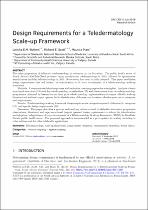JavaScript is disabled for your browser. Some features of this site may not work without it.
- ResearchSpace
- →
- Research Publications/Outputs
- →
- Journal Articles
- →
- View Item
| dc.contributor.author |
Walters, Laticha EM

|
|
| dc.contributor.author |
Scott, RE

|
|
| dc.contributor.author |
Mars, M

|
|
| dc.date.accessioned | 2018-07-31T09:35:38Z | |
| dc.date.available | 2018-07-31T09:35:38Z | |
| dc.date.issued | 2018-07 | |
| dc.identifier.citation | Walters, L.E.M., Scott, R.E. and Mars, M. 2018. Design requirements for a teledermatology scale-up framework. South African Computer Journal, vol. 30(1): 128-160 | en_US |
| dc.identifier.issn | 1015-7999 | |
| dc.identifier.issn | 2313-7835 | |
| dc.identifier.uri | http://sacj.cs.uct.ac.za/index.php/sacj/article/view/559 | |
| dc.identifier.uri | DOI: http://dx.doi.org/10.18489/sacj.v30i1.559 | |
| dc.identifier.uri | http://hdl.handle.net/10204/10333 | |
| dc.description | Copyright © 2018 The author(s); published under a Creative Commons NonCommercial 4.0 License (CC BY-NC 4.0) | en_US |
| dc.description.abstract | South Africa’s KwaZulu-Natal province began synchronous teledermatology in 2003, followed by spontaneous asynchronous (mobile) teledermatology in 2013. No scale-up has been formally planned. This paper establishes design requirements that will inform the identification or de novo development of a teledermatology scale-up framework. Methods: A requirements definition process with inductive reasoning approaches was applied. Analysis of semi-structured interviews (19) with key teledermatology stakeholders (17) and observations from two teledermatology programmes, informed by lessons learned from prior teledermatology implementation attempts, eHealth scale-up literature and authors’ expert opinion, led to identification of Themes, and iterative reflection gave rise to Categories and Requirements. Results: Teledermatology scale-up framework design requirements emerged comprised of themes (4), categories (12), and specific design requirements (30). Discussion: This paper describes a process and resulting evidence-based (stakeholder interviews; programme observations; literature) and experience-based (expert opinion) design requirements to inform the identification and adoption / adaptation or de novo development of a teledermatology scale-up framework (TDSF) for KwaZulu-Natal’s public health sector. The proposed approach is recommended as a pre-requisite for scaling, including in other settings and for other telehealth applications. | en_US |
| dc.language.iso | en | en_US |
| dc.publisher | SACJ | en_US |
| dc.relation.ispartofseries | Worklist;21163 | |
| dc.subject | Requirements definition | en_US |
| dc.subject | Requirements elicitation | en_US |
| dc.subject | Scale-up framework | en_US |
| dc.subject | Teledermatology | en_US |
| dc.title | Design requirements for a teledermatology scale-up framework | en_US |
| dc.type | Article | en_US |
| dc.identifier.apacitation | Walters, L. E., Scott, R., & Mars, M. (2018). Design requirements for a teledermatology scale-up framework. http://hdl.handle.net/10204/10333 | en_ZA |
| dc.identifier.chicagocitation | Walters, Laticha EM, RE Scott, and M Mars "Design requirements for a teledermatology scale-up framework." (2018) http://hdl.handle.net/10204/10333 | en_ZA |
| dc.identifier.vancouvercitation | Walters LE, Scott R, Mars M. Design requirements for a teledermatology scale-up framework. 2018; http://hdl.handle.net/10204/10333. | en_ZA |
| dc.identifier.ris | TY - Article AU - Walters, Laticha EM AU - Scott, RE AU - Mars, M AB - South Africa’s KwaZulu-Natal province began synchronous teledermatology in 2003, followed by spontaneous asynchronous (mobile) teledermatology in 2013. No scale-up has been formally planned. This paper establishes design requirements that will inform the identification or de novo development of a teledermatology scale-up framework. Methods: A requirements definition process with inductive reasoning approaches was applied. Analysis of semi-structured interviews (19) with key teledermatology stakeholders (17) and observations from two teledermatology programmes, informed by lessons learned from prior teledermatology implementation attempts, eHealth scale-up literature and authors’ expert opinion, led to identification of Themes, and iterative reflection gave rise to Categories and Requirements. Results: Teledermatology scale-up framework design requirements emerged comprised of themes (4), categories (12), and specific design requirements (30). Discussion: This paper describes a process and resulting evidence-based (stakeholder interviews; programme observations; literature) and experience-based (expert opinion) design requirements to inform the identification and adoption / adaptation or de novo development of a teledermatology scale-up framework (TDSF) for KwaZulu-Natal’s public health sector. The proposed approach is recommended as a pre-requisite for scaling, including in other settings and for other telehealth applications. DA - 2018-07 DB - ResearchSpace DP - CSIR KW - Requirements definition KW - Requirements elicitation KW - Scale-up framework KW - Teledermatology LK - https://researchspace.csir.co.za PY - 2018 SM - 1015-7999 SM - 2313-7835 T1 - Design requirements for a teledermatology scale-up framework TI - Design requirements for a teledermatology scale-up framework UR - http://hdl.handle.net/10204/10333 ER - | en_ZA |






